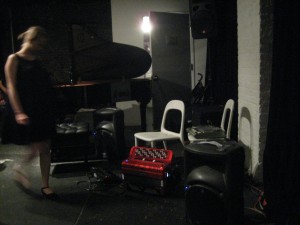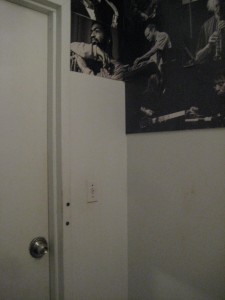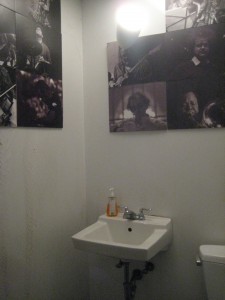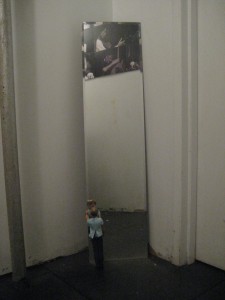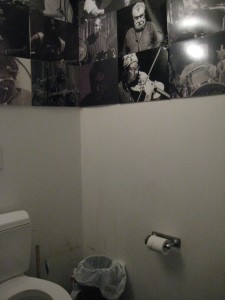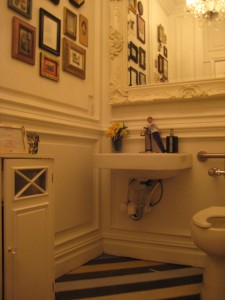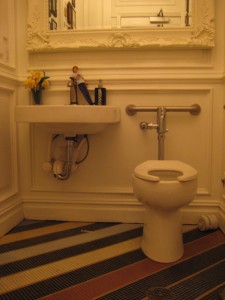The Stone
Posted: August 28, 2012 Filed under: East Village | Tags: TUESDAY TOILET TALK 1 Comment »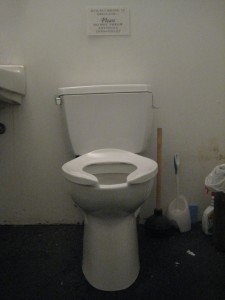 They say time flies. I blinked and ended up back at The Stone, the first music venue I checked out after moving here a year ago. I told myself last time to not return in the summer, as it gets unbearably stuffy in the small rectangular room when the noisy air conditioner is turned off during the performance. But I forgot about that. Thankfully, the weather this past Tuesday was relatively cool and the A/C was kept on for the second piece.
They say time flies. I blinked and ended up back at The Stone, the first music venue I checked out after moving here a year ago. I told myself last time to not return in the summer, as it gets unbearably stuffy in the small rectangular room when the noisy air conditioner is turned off during the performance. But I forgot about that. Thankfully, the weather this past Tuesday was relatively cool and the A/C was kept on for the second piece.
With my glasses sliding over the bridge of my nose from perspiration, my mind began to wander as I listened to the interaction between Pauline Oliveros (digital accordion), Susie Ibarra (drums) and Thollem McDonas (piano). I remembered the time I participated in Pauline’s workshop some years ago and the San Francisco Electronic Music Festival, where I heard her play duo with laptop, wishing I had earplugs to deflect the shimmery, metallic vibrations. I remembered the electric energy of spontaneous music making with strong improvisers committed not to a specific musical idiom, but to the moment. I remembered a little piece of myself that I had forgotten.
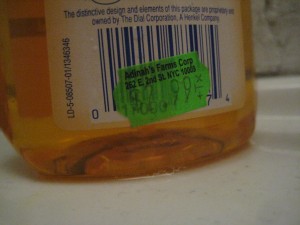 Along with the Village Vanguard’s ladies stalls, The Stone’s unisex restroom provided the impetus for this blog. Located immediately behind the performance area, there is no way that you or anyone else watching the show can miss the entrance to the restroom. And with just a flimsy button lock on the doorknob, you feel as though someone might accidentally fling the door open on you, making your private potty time a part of the performance. If you obey the sign discouraging bathroom use during the performance however, you won’t have to worry about having to improvise in the hypothetical situation. Just remember to use the bathroom during the break.
Along with the Village Vanguard’s ladies stalls, The Stone’s unisex restroom provided the impetus for this blog. Located immediately behind the performance area, there is no way that you or anyone else watching the show can miss the entrance to the restroom. And with just a flimsy button lock on the doorknob, you feel as though someone might accidentally fling the door open on you, making your private potty time a part of the performance. If you obey the sign discouraging bathroom use during the performance however, you won’t have to worry about having to improvise in the hypothetical situation. Just remember to use the bathroom during the break.
I went equipped with hand sanitizer and was pleased to see that they had soap this time, $2.99 plus tax from Adinah’s Farm market across the street. Maintaining restrooms, from purchasing the hand soap and toilet paper to calling the plumber costs money and I wondered how The Stone runs. This is the only club I know of in the city that does not sell drinks and has select musicians curate shows, with all cover revenue going directly to the performers.
As I continue to publish posts, I’m starting to exhaust the more commonly found languages for the concluding audio clip. I had counted on getting Tagalog for this issue but the person eventually and politely declined. You can tell quite a bit about one’s personality just by asking if you could record him/her saying “Where’s the restroom?” Some people don’t think twice, maybe laugh then say it, while others are much more cautious. It probably doesn’t put the careful personalities any more at ease when I say it’s for a blog on toilets. Please do warn friends that play or attend jazz clubs about JAZZ TOILET so that they are not taken aback when I pop the question.
A Spanish friend told me that there are some 6000 languages in the world and that there are 4 in his nation alone. I’m not sure how many are spoken in NYC but there are certainly more than I can cover in the lifetime of this blog. Cătălin from Romania tells us how to say, “Where’s the restroom?” in Romanian —
Ginny’s Supper Club
Posted: August 14, 2012 Filed under: Harlem | Tags: TUESDAY TOILET TALK 4 Comments »The air thick from too many people packed into the tight space, I slowly nudged my way toward the front until I could see bandleader Christian Scott. My brain’s immediate response: “He is brave; he is wearing polka dots. He is a trumpet player.” His music was as remarkable as his outfit and fitting of the rare man who can pull off polka dots. Joined by Matt Stevens (guitar), Lawrence Fields (piano), Kris Funn (bass) and Joe Dyson (drums), the band celebrated the release of a new album the Thursday before last at Ginny’s Supper Club.
Christian Scott quickly cleared up my confusion as to whether the venue was supposed to be a listening room or a lounge with background music when he told the audience in the back to shut up. True to his outspoken personality, he continued with his piece K.K.P.D. (Ku Klux Police Department), providing the backstory and commenting on the fact that these things are still happening today. I can believe that.
While I personally only know what it’s like to be an Asian woman in metropolitan areas, I’m certain that racism toward each of the many groups on the periphery of mainstream America is real. It seems like just yesterday that kids at school were pulling their eyes back, sputtering nonsensical syllables. Oh wait. That was the other day in Harlem when a grown woman called me “ching-ching.”
Hypersensitive? You tell me.
Ginny’s Supper Club has a rather high ratio of people needing to relieve themselves to number of toilets available and shares the two bathrooms with its parent restaurant, Red Rooster, upstairs on the ground level. I hastily investigated the bathroom on the left, remembering to press down gently on the soap pump as to not squirt my shirt like last time, and noted the sparkly chandelier hanging from the ceiling.
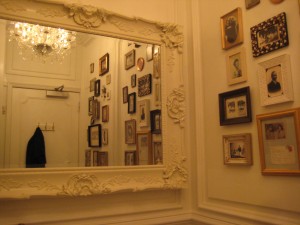 I only glanced briefly at the framed pictures covering the walls but I assume they were supposed to be a throwback to the Harlem Renaissance. Harlem seems to be undergoing a different kind of development now, one of gentrification, as the socioeconomic makeup of the neighborhood gradually changes. The restaurant fits the face of this new Harlem, with a menu that claims to reflect “the roots of Harlem’s diverse population,” but with prices affordable to a select population.
I only glanced briefly at the framed pictures covering the walls but I assume they were supposed to be a throwback to the Harlem Renaissance. Harlem seems to be undergoing a different kind of development now, one of gentrification, as the socioeconomic makeup of the neighborhood gradually changes. The restaurant fits the face of this new Harlem, with a menu that claims to reflect “the roots of Harlem’s diverse population,” but with prices affordable to a select population.
I can’t help but feel a strange sense of irony.
Still, the recently opened venue is noteworthy in that it is under black ownership. How many jazz clubs can you think of that can say that? Or jazz anything that’s under the management of black people, who created the very genre? My sister also reminded me that a key premise to this blog, the toilet as a shared experience for everyone regardless of race or other segregating factors, wasn’t always the case. I have to thank her for providing nuanced insight into this issue’s toilet. It’s no wonder that as kids, she brought home the African-American History Bee trophy while the only shiny thing I brought home was glitter glue.
Stanley from Haiti, who works at the bar, tells us how to say, “Where’s the restroom?” in Creole –
[EDIT] Please see the comments section for a correction to an error in the last paragraph.
Friday Flush, Issue 2
Posted: August 3, 2012 Filed under: Ken® | Tags: FRIDAY FLUSH 1 Comment »Hey dudes and dudettes—I’m back for the second issue of Friday Flush!
It hasn’t been easy keeping this beach body solid with so many happening barbeques in July. And you know what a lot of hot dogs and burgers mean … more toilet usage. Ever wonder what happens after you flush?

Anyway, my summer has been just phenomenal so far. I watched the documentary Still Bill on the soul brother Bill Withers and found out that he had a job making toilets for 747 aircrafts before he became an American icon. Right on. I get stoked about stuff, while seating and thinking on the toilet seat; actually making toilets must be a whole other level of magic.
In Bill’s own words: “I installed cameras in those toilets … So if you’ve ever been to the bathroom on a 747, I know you very well—you understand?”
I want to give a shout-out to everyone that has sent suggestions for future flushes through email, facebook and twitter. Keep them coming and you can comment below too!
–
Staff writer/model Ken® has appeared in the short, Hawaiian Vacation (2011), and numerous other features, making his first appearance in the 60′s. He has been named (the boyfriend of) one of the most influential cultural icons of the century and is a true renaissance man, with skills ranging from leading safaris in the wild to shaving without gel in the concrete jungle. Ken® currently resides in Manhattan but vacations frequently at his dream house in Malibu.

